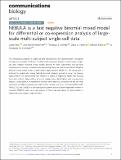| dc.contributor.author | He, Liang | |
| dc.contributor.author | Davila-Velderrain, Jose | |
| dc.contributor.author | Sumida, Tomokazu S | |
| dc.contributor.author | Hafler, David A | |
| dc.contributor.author | Kellis, Manolis | |
| dc.contributor.author | Kulminski, Alexander M | |
| dc.date.accessioned | 2022-07-13T17:06:57Z | |
| dc.date.available | 2022-07-13T17:06:57Z | |
| dc.date.issued | 2021 | |
| dc.identifier.uri | https://hdl.handle.net/1721.1/143719 | |
| dc.description.abstract | <jats:title>Abstract</jats:title><jats:p>The increasing availability of single-cell data revolutionizes the understanding of biological mechanisms at cellular resolution. For differential expression analysis in multi-subject single-cell data, negative binomial mixed models account for both subject-level and cell-level overdispersions, but are computationally demanding. Here, we propose an efficient NEgative Binomial mixed model Using a Large-sample Approximation (NEBULA). The speed gain is achieved by analytically solving high-dimensional integrals instead of using the Laplace approximation. We demonstrate that NEBULA is orders of magnitude faster than existing tools and controls false-positive errors in marker gene identification and co-expression analysis. Using NEBULA in Alzheimer’s disease cohort data sets, we found that the cell-level expression of <jats:italic>APOE</jats:italic> correlated with that of other genetic risk factors (including <jats:italic>CLU, CST3, TREM2</jats:italic>, C1q, and <jats:italic>ITM2B</jats:italic>) in a cell-type-specific pattern and an isoform-dependent manner in microglia. NEBULA opens up a new avenue for the broad application of mixed models to large-scale multi-subject single-cell data.</jats:p> | en_US |
| dc.language.iso | en | |
| dc.publisher | Springer Science and Business Media LLC | en_US |
| dc.relation.isversionof | 10.1038/S42003-021-02146-6 | en_US |
| dc.rights | Creative Commons Attribution 4.0 International license | en_US |
| dc.rights.uri | https://creativecommons.org/licenses/by/4.0/ | en_US |
| dc.source | Nature | en_US |
| dc.title | NEBULA is a fast negative binomial mixed model for differential or co-expression analysis of large-scale multi-subject single-cell data | en_US |
| dc.type | Article | en_US |
| dc.identifier.citation | He, Liang, Davila-Velderrain, Jose, Sumida, Tomokazu S, Hafler, David A, Kellis, Manolis et al. 2021. "NEBULA is a fast negative binomial mixed model for differential or co-expression analysis of large-scale multi-subject single-cell data." Communications Biology, 4 (1). | |
| dc.contributor.department | Massachusetts Institute of Technology. Computer Science and Artificial Intelligence Laboratory | |
| dc.relation.journal | Communications Biology | en_US |
| dc.eprint.version | Final published version | en_US |
| dc.type.uri | http://purl.org/eprint/type/JournalArticle | en_US |
| eprint.status | http://purl.org/eprint/status/PeerReviewed | en_US |
| dc.date.updated | 2022-07-13T16:49:30Z | |
| dspace.orderedauthors | He, L; Davila-Velderrain, J; Sumida, TS; Hafler, DA; Kellis, M; Kulminski, AM | en_US |
| dspace.date.submission | 2022-07-13T16:49:32Z | |
| mit.journal.volume | 4 | en_US |
| mit.journal.issue | 1 | en_US |
| mit.license | PUBLISHER_CC | |
| mit.metadata.status | Authority Work and Publication Information Needed | en_US |
